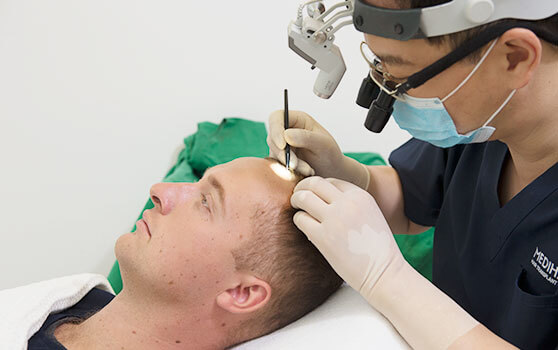
What Is the Best Treatment for Hair Loss : A Complete Guide for Patients
Quick Answer: There is no single best treatment for hair loss. The right approach depends on the cause, stage of thinning, age, and medical suitability. Options range from medications and topical therapies to non-surgical treatments and hair transplant surgery. The most effective results usually come from combining treatments and planning for long term stability under the care of an experienced doctor.
Understanding Hair Loss
Hair loss affects millions of men and women worldwide. It can start gradually with thinning at the crown or hairline, or it may appear suddenly due to illness or stress. The most common type is androgenetic alopecia, known as male or female pattern baldness, caused by a combination of genetics and sensitivity to the hormone dihydrotestosterone (DHT). This hormone shrinks follicles over time, producing finer hair until growth stops altogether.
Other common triggers include:
- Thyroid disease
- Autoimmune conditions such as alopecia areata
- Hormonal changes
- Iron or vitamin deficiencies
- Prolonged stress or serious illness
- Medications
Because there are so many possible causes, it is important to have a consultation before starting any treatment.
Treatment Options Explained
Prescription Medications
For men, finasteride is often prescribed to lower DHT levels. It can slow progression and sometimes improve density. For women, spironolactone or certain hormonal therapies may be considered. These treatments need ongoing medical monitoring because they can cause side effects and are not suitable for everyone.
Topical Therapies and Over the Counter Products
Minoxidil is the most recognised topical solution for hair loss and is also available in an oral form. It works by improving blood supply to follicles and supporting the growth phase of hair. Many over the counter products include vitamins, botanical extracts, or mild DHT blockers. While they may help as supportive care, they are rarely effective as stand-alone solutions.
Non-Surgical Treatments
Some patients use therapies that stimulate or support the scalp environment, including:
Platelet Rich Plasma (PRP) injections, which deliver growth factors from your own blood
Low Level Laser Therapy (LLLT), designed to improve circulation
Microneedling, sometimes combined with topical applications
These treatments may help maintain existing hair when used alongside medications or topical therapies.
Hair Transplant Surgery
For advanced thinning or balding, surgery is sometimes the only option to restore visible density. Two main techniques are used: Follicular Unit Extraction (FUE) and Follicular Unit Transplant (FUT). Both methods move healthy follicles from the donor area, usually the back of the scalp, to thinning areas.
While transplants can provide permanent growth in treated zones, they do not stop the underlying hair loss process. Ongoing management is usually required. Success depends on donor availability, medical planning, and surgical expertise.
Recovery and Results Timeline
Whichever treatment path you take, results take time.
Week 1: after surgery, some redness, swelling, or scabbing may appear
Month 1: transplanted hairs or existing hairs may shed, which is normal
Months 3 – 4: early regrowth begins, usually thin and fine
Month 6: thickening becomes more visible
Month 12: most final results are established, with small improvements up to 18 months
Patients who understand this timeline are less likely to feel discouraged during the early stages.
Long Term Planning Is Essential
Hair loss is usually progressive, which means planning is critical. Donor follicles are limited and once used in a transplant they cannot be replaced. Doctors must therefore design a strategy that conserves grafts, creates natural looking hairlines that will age well, and integrates medications to preserve existing hair.
Short term fixes that promise instant density can be misleading. Overuse of donor follicles may leave you with little flexibility for future procedures. The best treatment plans focus on both immediate results and long-term sustainability.
FAQs
Q: Is finasteride safe for everyone
A: No. It must be prescribed by a doctor and is not suitable for men planning children or for women who are pregnant or breastfeeding.
Q: Does minoxidil work on its own
A: It can help, particularly in early stages, but results are stronger when combined with other treatments.
Q: Are PRP or laser treatments proven
A: They show supportive benefits in many patients, especially when combined with medical therapy, but outcomes vary.
Q: Who should consider hair transplant surgery
A: Patients with stable donor supply, realistic expectations, and a confirmed diagnosis of pattern hair loss.
Q: Do hair transplants cure baldness
A: No. They restore density in selected areas, but non transplanted hair may continue to thin without medical support.
Q: How long before I notice improvement
A: Most patients begin to see changes after three to four months, with results continuing to develop for up to 18 months.
Why Choose Medihair
At Medihair, treatment recommendations are based on medical evidence and patient suitability. Technology and supportive therapies are used where they add value, but decisions always rest with experienced AHPRA registered doctors. Patients receive honest education about what is possible and are guided through a long term plan that prioritises safety and natural looking outcomes.

Book a Consultation
Medihair offers an obligation free consultation either online or in person.
To book, call 1300 355 325 or Click Here.
Disclaimer: All medical and surgical procedures carry risks. Results vary from person to person. This article is intended for education only and should not replace medical advice. Always seek a second opinion from an appropriately qualified health practitioner before beginning treatment. Images, if used, are for illustrative purposes only.
AUTHOR
Bianca Shaw
A well-respected surgical stylist, Bianca Shaw has worked in the hair loss industry for 28 years, educating and supporting patients, and working alongside many of Australia’s leading surgeons. Qualified in Trichology and Hairdressing, Bianca was initially trained by a leading hair transplant surgeon and can perform a range of procedures including hair line design, placement of grafts for maximum density, and the dissection and implantation of hair follicles.
Having worked for leading hair loss companies, and managing a number of successful hair transplant practices, Bianca is committed to helping patients understand the treatment options available, ensuring they make the best decision and get the best results to improve their appearance and quality of life.
